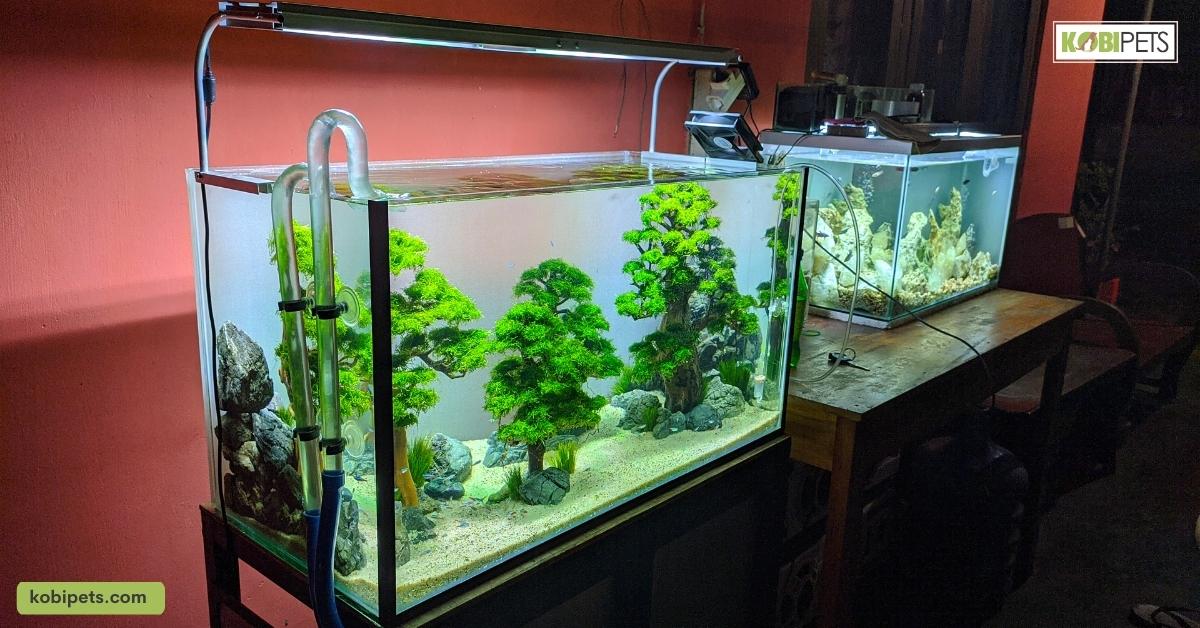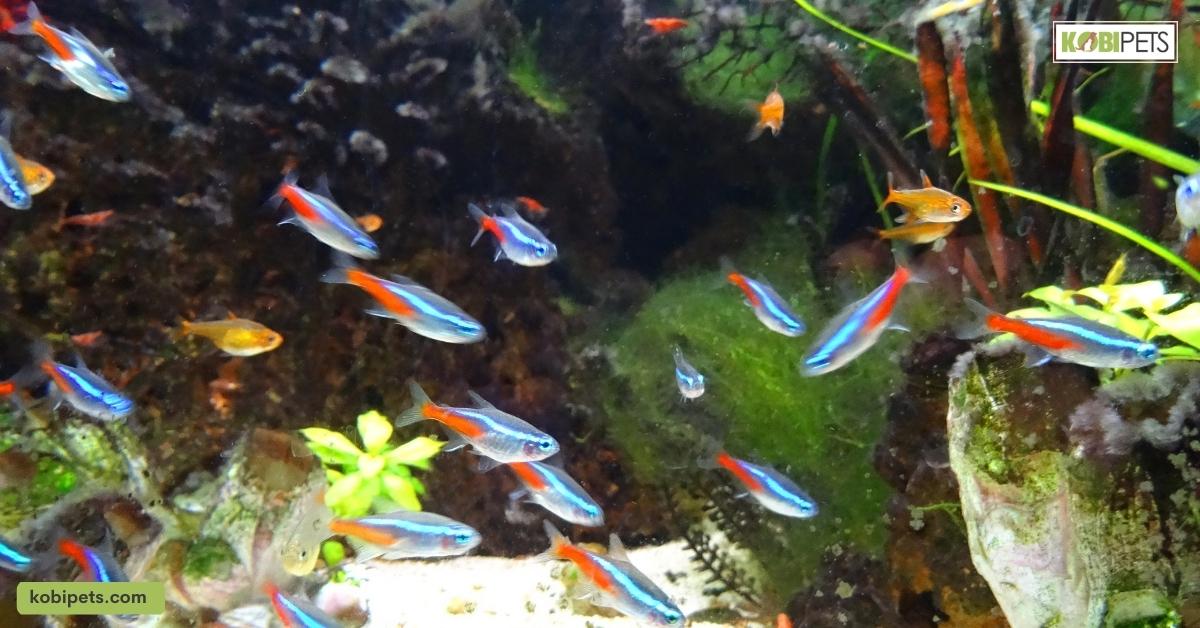If you’re looking for a reliable and cost-effective way to keep your aquarium clean, then an under gravel filter might be just what you need. Undergravel filters are popular for their efficiency and ease of use, and they’re a great choice for aquariums of all sizes.
Undergravel filters are a popular choice for aquarium enthusiasts looking for an effective and affordable way to maintain a clean and healthy environment for their aquatic pets. This type of filter works by pulling water through a layer of gravel at the bottom of the tank, where beneficial bacteria break down waste.
How Undergravel Filters Work
Undergravel filters are a popular choice for aquarium enthusiasts who want to maintain clean and healthy water conditions for their aquatic pets. The mechanism behind this type of filter is relatively simple, yet effective. A series of plates are placed at the bottom of the aquarium and covered with gravel.
Water is then drawn into the filter through a tube, and passes through the porous gravel bed. The gravel acts as a biological filter, housing beneficial bacteria that remove harmful toxins and waste from the water.
Additionally, the action of water passing through the gravel bed generates a flow that helps distribute essential oxygen and nutrients to the entire tank. With proper maintenance, under gravel filters can be highly effective in creating a healthy environment for fish, plants, and other aquarium inhabitants.
Benefits of Undergravel Filters
Undergravel filters are a popular choice for aquarium enthusiasts looking for an effective and affordable way to maintain a healthy, clean environment for their aquatic pets. These filters work by pulling water through a layer of gravel at the bottom of the tank, where beneficial bacteria break down waste and help keep the water clear.
Here are the benefits of using undergravel filters:
- Increased oxygenation: Undergravel filters promote better oxygenation in your aquarium, which is essential for the health and well-being of your fish and other aquatic creatures. The filter pulls water through the gravel, which helps to create a natural flow of oxygen-rich water throughout the tank.
- Cost-effective: Undergravel filters are an affordable option for aquarium enthusiasts who want to maintain a clean and healthy environment for their aquatic pets without breaking the bank. They are simple to install and require minimal maintenance, making them a great choice for beginners.
- Effective waste removal: Undergravel filters are highly effective at removing waste and debris from your aquarium. The gravel layer acts as a natural filter, trapping and breaking down waste so that it can be easily removed during routine tank maintenance.
- Promotes healthy bacteria growth: Undergravel filters are designed to encourage the growth of beneficial bacteria in your aquarium. These bacteria help to maintain a stable and healthy ecosystem, breaking down harmful toxins and keeping your fish and other aquatic creatures healthy.
Setting Up an Undergravel Filter System
An undergravel filter system is an effective and affordable way to maintain a clean and healthy environment for your aquarium. With a few simple steps, you can install an undergravel filter that will help keep your fish and other aquatic creatures happy and healthy.
- Setting up an under-gravel filter system is relatively easy and can be done with minimal time and effort. Here are the steps for setting up this type of filtration system:
- Place the filter plates at the bottom of your aquarium, ensuring that they are evenly distributed.
- Spread a layer of gravel over the plates, making sure to cover them completely.
- Connect a tube from an air pump to the filter plate, allowing oxygen-rich water to be drawn in and distributed throughout the aquarium.
- Place your aquarium decorations and plants over the gravel bed, ensuring that they do not block or obstruct any of the tubes or plates.
- Connect the air pump to an outlet and turn it on to start the filtration process.
Once your filter is set up, you should perform regular maintenance checks to ensure that it is functioning properly. This includes cleaning the gravel bed regularly, checking for any clogs or obstructions in the tubes, and inspecting the filter plates for any signs of damage or wear.
Suitable Tank Size for Undergravel Filters
Undergravel filters are an effective and affordable way to keep aquarium water clean and healthy. They work by pulling water through a gravel bed at the bottom of the tank, where beneficial bacteria break down waste.
Here’s a guide to choosing the right tank size for your undergravel filter:
| Tank Size | Undergravel Filter Size |
|---|---|
| 10-20 gallons | 8″ x 16″ |
| 20-30 gallons | 12″ x 24″ |
| 30-40 gallons | 12″ x 36″ |
| 40-50 gallons | 18″ x 48″ |
As you can see from the table above, the size of your undergravel filter will depend on the size of your aquarium. It’s important to choose a filter that is large enough to effectively filter the water in your tank, but not so large that it takes up too much space or overwhelms your aquatic pets.
For smaller tanks, such as those between 10-20 gallons, an 8″ x 16″ undergravel filter should be sufficient. For larger tanks, such as those between 40-50 gallons, an 18″ x 48″ filter is recommended.
Proper Maintenance of Undergravel Filters
Proper maintenance of an undergravel filter is essential for keeping your aquarium clean and healthy. This includes cleaning the gravel bed regularly, checking for any clogs or obstructions in the tubes, and inspecting the filter plates for any signs of damage or wear. Additionally, it’s important to check the water levels in your tank at least once a week and replace any water that has evaporated.
To ensure that your filter continues to work properly, you should also perform regular maintenance checks on the system itself. This includes cleaning out the gravel bed by removing any debris or build-up, checking for clogs in the tubes, and inspecting the filter plates for any signs of damage or wear.
Additionally, it’s important to check the water levels in your tank at least once a week and replace any water that has evaporated.
Potential Drawbacks of Undergravel Filters
Undergravel filters are a popular choice for aquarium enthusiasts, offering an effective and affordable way to maintain a clean and healthy environment for their aquatic pets. Despite their many advantages, there are some potential drawbacks to using undergravel filters that may make them unsuitable for certain tanks.
Here are some of the potential drawbacks of undergravel filters:
- Limited filtration: Undergravel filters are for water through a layer of gravel at the bottom of the tank. While this provides some filtration, it may not be sufficient for larger aquariums or tanks with a high bioload.
- Increased maintenance: Undergravel filters require regular maintenance to ensure that they are working effectively. This includes cleaning and replacing the gravel layer, which can be time-consuming and messy.
- Limited oxygenation: While undergravel filters do promote better oxygenation in your aquarium, they may not be sufficient for tanks that require higher levels of oxygenation, such as those with a high bioload or particularly active aquatic pets.
- Potential for clogging: Undergravel filters can become clogged over time, especially if they are not properly maintained. This can lead to reduced filtration and potentially harmful conditions for your aquatic pets.
Compatible Tank Inhabitants for Undergravel Filters
Undergravel filters are a popular choice for aquarium enthusiasts looking for an effective and affordable way to maintain a clean and healthy environment for their aquatic pets. This type of filter works by pulling water through a layer of gravel, where beneficial bacteria break down waste.
Freshwater Fish
Most freshwater fish are compatible with undergravel filters since these filters provide a natural and healthy environment. They help to create stable water chemistry and promote healthy bacterial growth. Some of the most common freshwater fish that are compatible with undergravel filters include tetras, barbs, danios, and gouramis.
Invertebrates
Invertebrates such as snails, shrimp, and crabs can also thrive in tanks with undergravel filters. These creatures help to clean up the tank by consuming waste and debris, which helps to promote a healthy environment for your aquatic pets.
Live Plants
Live plants are also compatible with undergravel filters since they help to create a natural and healthy environment for your aquatic pets. They absorb nutrients from the water, which helps to prevent the buildup of harmful toxins. Some of the most common live plants that are compatible with undergravel filters include java fern, anubias, and marimo moss balls.
Bottom Feeders
Bottom feeders such as catfish and loaches can also thrive in tanks with undergravel filters. These creatures help to clean up the tank by consuming waste and debris, which helps to promote a healthy environment for your aquatic pets.
Snails
Snails can also be great additions to tanks with undergravel filters since they help to clean up the gravel layer. They consume algae and other debris, which helps to prevent the buildup of harmful toxins.
Additional Filtration Options with Undergravel Filters
Undergravel filters are a popular choice for aquarium enthusiasts looking for an effective and affordable way to maintain a clean and healthy environment for their aquatic pets. This type of filter works by pulling water through a layer of gravel, where beneficial bacteria break down waste. However, some tanks may require additional filtration options in order to create the ideal aquatic environment.
Canister Filters
Canister filters are an additional filtration option in conjunction with undergravel filters to create the best environment for your aquarium inhabitants. Canisters are larger than other types of filters, which makes them ideal for tanks that require higher levels of filtration or have a high bioload.
Canister filters can be used to remove waste and debris from the water, as well as provide oxygenation and circulation.
Power Filters
Power filters are another additional filtration option that can work in conjunction with undergravel filters to create a clean and healthy environment for your aquarium inhabitants. These types of filters are designed to hang on the back of the tank and use a motor to pull water into the filter, where it passes through several layers of filtration media.
UV Sterilizers
UV sterilizers are an additional filtration option in conjunction with undergravel filters. These devices use ultraviolet light to kill harmful bacteria and parasites, which helps to keep your aquarium clean and safe for your aquatic pets. UV sterilizers are ideal for tanks with a higher bioload or those that require additional filtration.
In conclusion
Undergravel filters are an affordable and effective way to maintain a healthy aquarium. They work by using the natural process of beneficial bacteria to remove waste and toxins from the water.
They also promote the growth of live plants, which help to further clean the water and provide a natural habitat for fish. It is important to choose the right size filter and to properly maintain it through regular cleaning and replacement of filter cartridges.















